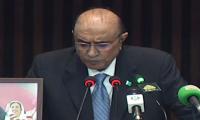Back in 1991, the MQM’s dynamic young mayor of Karachi, Farooq Sattar, inaugurated Mukka Chowk, near the party’s headquarters. At the time, the MQM was serving in the military-proxy government of the IJI.
In 2009, Mukka Chowk was refurbished by another dynamic young MQM mayor, Mustafa Kamal, and a plaque was installed bearing a quote of Altaf-in-exile: “Distance does not matter”. At that time, the MQM was just a year removed from serving in the military-proxy government of the PML-Q.
Seven years proved to be too long a distance. One of the dynamic young mayors has now named himself the new leader of the MQM. The other dynamic young mayor has formed – or rather had formed for him – a new political party whose only selling point is supposed to be that it is not the MQM. Mukka Chowk has been renamed as Shaheed-e-Millat Liaquat Ali Khan Chowk and all the Altaf Hussain paraphernalia surrounding it deposited in the nearest trash can. This time, the MQM is facing the wrath of the military-proxy Rangers.
Anyone visiting Karachi who passed Mukka Chowk assumed its menacing golden fist belonged to Altaf Hussain. It was actually meant to symbolise Liaquat Ali Khan’s fury towards India. Its true symbolic purpose now is to serve as a reminder of how most people’s understanding of the MQM is as mistaken as its belief that the fist was Altaf’s.
Ask anyone to do a word association test for the MQM and the likely responses will be “target killing”, “extortion”, “land grabbing” and the like. And the MQM is all those things and more. But here’s the thing: so is every other political party. Just as the MQM patronises criminal gangs as a way to maintain its hold on political power, so do most other politicians in rural Sindh and Punjab.
The link between power, violence and land is as old as the story of the Subcontinent. The difference between other politicians and those of the MQM is that their violence is an accepted fabric of society because it has been passed down from generations – and usually stayed within the same families – and is un-ideological while the violence of the MQM is seen to have the added explosive ingredient of nationalism – Mohajir nationalism in this case. That is why when, say, then Sindh chief minister Jam Sadiq Ali was found in the 1990s to be involved with dacoits from rural Sindh who had kidnapped Japanese visitors it did not lead to calls for banning the PPP and branding it a terrorist party. That is also why when PML-N councillors and MPAs are accused of extortion – as they are every few months – it is not seen as a uniquely PML-N problem.
Ethnic nationalism in Pakistan has never been accepted and usually brutally suppressed and/or marginalised by the Punjabi-dominated establishment and elite, be it of the Baloch, Gilgit-Baltistan or Seraiki variety. Mohajirs aren’t an ethnicity and neither are they all Urdu-speaking, and they were even part of the governing elite at least until being sidelined by Ayub Khan but their treatment has not been very different to that of ethnic nationalists.
Branded as traitors and accused of being stooges for Indian machinations to break up the country, they have been subjected to the usual tricks, most notoriously with the Jinnahpur incident in 1992 when it was claimed that maps of a proposed breakaway Mohajir state had been found in the MQM’s offices. It was this bogus map which was used as a pretext for launching the notorious Operation Clean Up.
That the Jinnahpur map and Mohajir independence plan was believed by so many shows how effective the mistaken conflation of the MQM with Mohajir nationalism has been and how poorly the party is understood. The MQM has been trying to show how Mohajir identity co-exists within the Pakistani state for years, starting with changing the ‘Mohajir’ in its name to ‘Muttahida’ and, more concretely, projecting Mohajirs as Urdu-speaking Sindhis to give the community a connection to the rest of the province.
And yet the RAW agent smears persist and the party portrayed as uniquely evil. The MQM is the legitimate representative of Mohajirs in urban Sindh but that does not mean it holds the slightest separatist sentiment.
Depicting the MQM as uniquely violent causes a misunderstanding of the different types of political violence in the country, which fall into many categories. There is the use of the police and other law-enforcement parties as an adjunct of the political party, something the MQM has been guilty of but again not uniquely so – after all the term ‘encounter’ was first devised in the Punjab of the 1980s when it was ruled by the PML-N.
The second type of violence which the MQM has been guilty of, and for which it is facing repercussions right now, was carried out at the behest of others, such as on May 12, 2007. For that type of violence to be eliminated, it is not just the MQM but those in the establishment who used and disposed of it on the basis of need who need to be reformed.
The third kind of violence – and this is the kind for which the MQM and the political culture of Pakistan can be indicted – is that which is perpetrated by the party to exact revenge on rivals and enemies and extend its territorial influence. Examples of such violence would include target killings and the Baldia Town factory fire. It is here that the new leadership of the party needs to rein in its own worst instincts.
Farooq Sattar and the rest of the Rabita Committee may be too enmeshed in the MQM’s way of doing things to be able to change and the worry is that they will simply put their heads down and try to ride out its current problems. As the custodians of Karachi, with a following which dwarfs that of all other political parties put together, the MQM has a responsibility to change the political culture of the city, even if it costs them a few areas of influence in the short term. The alternative is the perpetuation of the myth that the party’s violent tendencies are uniquely disqualifying in a way that they aren’t for anyone else.
The MQM is the legitimate voice for millions of Mohajirs and any attempt to silence it forever will been seen as a way to silence those millions of people. This is why it is still an electoral juggernaut while the establishment umbrellas under which it served are now either extinct, as the IJI, or hollowed-out husks, like the PML-Q. There is broad acceptance of the need to jettison Altaf Hussain post-haste and the MQM now has to take the opportunity to show that the party is not captive to the cult of an individual – another widely-held misconception about the MQM. But it can only grasp that opportunity if it is allowed to do so by the powers-that-be.
Giving the MQM space to breathe and actually trying to understand it rather than perpetuate convenient assumptions is the responsibility of the establishment. Positively using that space if it is afforded it is the duty of the MQM.
The writer is a journalist based in Karachi.
Email: nadir.hassan@gmail.com
India uses Afghanistan as a backstage area to carry out terrorist attacks against Pakistan
Another report by the Pakistan Institute of Peace Studies states that 78 per cent of attacks have been carried out by...
Pakistan stands at the forefront of this crisis, generating a staggering 3.3 million tonnes of plastic waste annually
Today, a total of 11,000 children are attending Daanish schools in Punjab
The emotional instability of parents inculcates a range of psychological issues in children
The current way of dealing with the environment and climate change is no longer adequate







